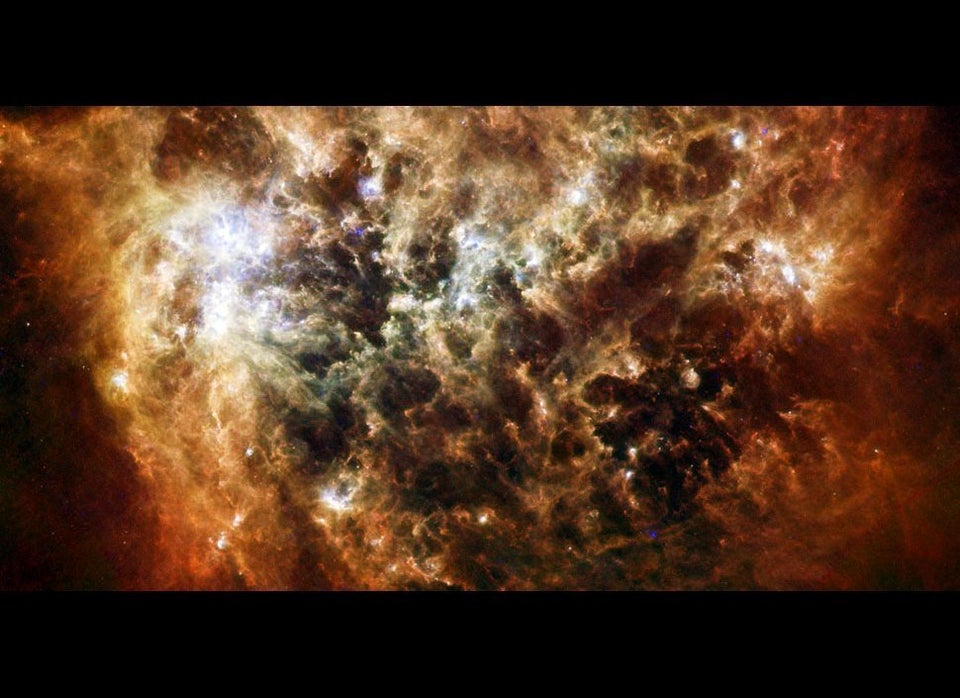By: Clara Moskowitz
Published: 09/27/2012 05:35 PM EDT on SPACE.com
For the first time, scientists have peered to the edge of a colossal black hole and measured the point of no return for matter.
A black hole has a boundary called an event horizon. Anything that falls within a black hole's event horizon — be it stars, gas, or even light — can never escape.
"Once objects fall through the event horizon, they're lost forever," Shep Doeleman, assistant director of the MIT Haystack Observatory and research associate at the Smithsonian Astrophysical Observatory, said in a statement Thursday (Sept. 27). "It's an exit door from our universe. You walk through that door, you’re not coming back."
Although the event horizon is an imaginary line that's impossible to observe, astronomers have imaged the region around a giant black hole at the center of a distant galaxy, and measured, for the first time, the closest stable orbit in which matter can circle the black hole. The findings were reported today in the journal Science.
The supermassive black hole in question lies at the center of the galaxy M87, which is about 50 million light-years from our own Milky Way. This behemoth black hole contains the mass of 6 billion suns.
Using a new observatory called the Event Horizon Telescope, which links up radio dishes in Hawaii, Arizona and California, astronomers measured that the innermost possible orbit for matter around the black hole is roughly 5.5 times the size of the black hole's event horizon.
This innermost orbit is about five times the size of the solar system, or 750 times the distance from Earth to the sun, Doeleman told SPACE.com. The distance between the Earth and the sun is nearly 93 million miles (150 million kilometers).
The observations allowed the researchers to confirm that this swirling mass around the black hole is the source of the powerful jets of light seen radiating from the galaxy. Many galaxies throughout the universe spot similar jets, thought to be produced by matter falling into their central black holes. Until now, no telescope has had the resolution power to verify the idea.
The Event Horizon Telescope is a new project that aims to link as many as 50 radio dishes around the world to work in concert to image the distant universe. Already, the observatory can see celestial objects with 2,000 times more detail than the Hubble Space Telescope.
You can follow SPACE.com on Twitter @Spacedotcom. We're also on Facebook & Google+.
Copyright 2012 SPACE.com, a TechMediaNetwork company. All rights reserved. This material may not be published, broadcast, rewritten or redistributed.
Support HuffPost
Our 2024 Coverage Needs You
Your Loyalty Means The World To Us
At HuffPost, we believe that everyone needs high-quality journalism, but we understand that not everyone can afford to pay for expensive news subscriptions. That is why we are committed to providing deeply reported, carefully fact-checked news that is freely accessible to everyone.
Whether you come to HuffPost for updates on the 2024 presidential race, hard-hitting investigations into critical issues facing our country today, or trending stories that make you laugh, we appreciate you. The truth is, news costs money to produce, and we are proud that we have never put our stories behind an expensive paywall.
Would you join us to help keep our stories free for all? Your contribution of as little as $2 will go a long way.
Can't afford to donate? Support HuffPost by creating a free account and log in while you read.
As Americans head to the polls in 2024, the very future of our country is at stake. At HuffPost, we believe that a free press is critical to creating well-informed voters. That's why our journalism is free for everyone, even though other newsrooms retreat behind expensive paywalls.
Our journalists will continue to cover the twists and turns during this historic presidential election. With your help, we'll bring you hard-hitting investigations, well-researched analysis and timely takes you can't find elsewhere. Reporting in this current political climate is a responsibility we do not take lightly, and we thank you for your support.
Contribute as little as $2 to keep our news free for all.
Can't afford to donate? Support HuffPost by creating a free account and log in while you read.
Dear HuffPost Reader
Thank you for your past contribution to HuffPost. We are sincerely grateful for readers like you who help us ensure that we can keep our journalism free for everyone.
The stakes are high this year, and our 2024 coverage could use continued support. Would you consider becoming a regular HuffPost contributor?
Dear HuffPost Reader
Thank you for your past contribution to HuffPost. We are sincerely grateful for readers like you who help us ensure that we can keep our journalism free for everyone.
The stakes are high this year, and our 2024 coverage could use continued support. If circumstances have changed since you last contributed, we hope you’ll consider contributing to HuffPost once more.
Already contributed? Log in to hide these messages.

